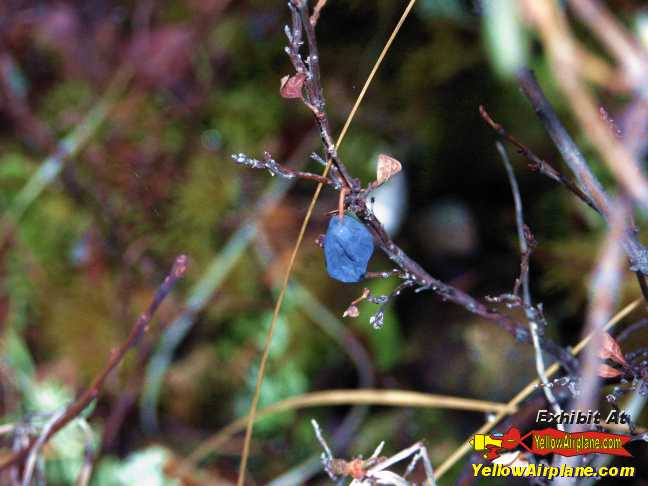|
This appears to be a Western Blueberry,
Vaccinium occidentale, which grows as a low shrub around wet meadows and
along streams from 5000 to 11,000 feet or higher. From a
personal experience you will be very lucky to see anything above 10,000 feet.
Field guide books are great. Be
sure you read the book very carefully before going on an exploratory trip and
make sure that you see what the plant looks like in various stages of
development. This is one big drawback of the guide books, they usually
show only one stage of the plants development, or their photos may not be very
well taken or the photos have poor color reproductions, or even, the books only
show a hand drawn picture.
The photo that I took above is a perfect
example of a bad photo for survival purposes. Sure you can see a
blueberry, but what do the leaves look like? Is this really a western
blueberry? Is it really eatable?
So here's an observation from an old
mountain climber and backwoods hiker, me. When we went into the mountains
or backwoods, we brought most of our own food and didn't collect it from the
wild. So after many years of back country hiking, I still cannot tell you
which plant is really which. For survival purposes an old time hiker can
be a super asset as a companion, but with all of the modern hiking methods of
bringing our own food as our primary source of nutrition left me way behind in
true survival in the wilderness.
Just buying and reading a book can be a
great help, but when you first start hiking, start by taking your book with you
and learning to identify wild food plants. When you are a beginner, don't
just go out and say you are going to start eating the plants as soon as you
think you can recognize them, instead, learn to identify them again and again.
Look at the leaves and the stems and start comparing these to pictures in books,
more than one book, before you actually start trying wild foods.
When you first start thinking that you
are getting pretty good at recognizing the plants, this is when you are in great
danger. This may sound like I'm jumping around a little here, but riding
motorcycles is where I learned this idea. Just when I was feeling that I'm
getting pretty good, I was a pretty good beginner, that's the secret word,
beginner.
There was a cassette tape course written
by Ron Ein that was called "Peak to Peak." In this tape course he talks
about this very subject. When you feel like you are getting to a peak in
your education or experience, you are getting to the top of your level.
But, you are entering the bottom of the next level and you cannot even see this
next level until you enter this.
Going back to motorcycle riding, when I
thought I was fast on the track, I was a slug. I've seen this peak to peak
method many happen many times in motorcycle riding. Now I'm an old
motorcycle rider with about eight hundred thousand miles. I raced flat
track, motocross, road racing and drag racing. I've been a race team
manager in road racing for five years and founded, managed, and promoted the
March of Dimes Race Team for five years and been a race track announcer for
eighteen years. Now I still feel like a beginner because there is still so
much to learn.
This is the peak to peak method of
backpacking and wilderness survival, you will always be a beginner, and when you
start feeling like you're an expert, look out, trouble awaits you.
Making a short story long, on this trip
to Alaska I met a bear hunter guide in Alaska at the Anchorage Airport. He
was calling one person after another on his cell phone and chatting about his
great experiences and he's now back. When we sat down and talked, he told
me about all of his success stories. At the same time, I was telling him
about all of the mistakes that I have made. It turns out that he never any
mistakes. Well, he was a beginner. This was his first trip leading
an expedition and he never had any mistakes. If you have never made any
mistakes, you are inexperienced and you are hitting your first peak. The
people who fail the most are the people who tried the most. If you never
failed, you never tried.
This bear hunter started talking to me
like I was a goof up, but I was hiking in the mountains, spent six years in the
US Navy, and have worked and led North Pole expeditions for nine years, and I
made a lot of mistakes. You learn from your mistakes. This is the
way it is for eating wild foods, but a mistake in eating wild foods can leave
you in serious trouble. This bear hunter, having no mistakes, is looking
for huge trouble for both himself and his guest that he's leading into the
wilderness.
The last thing that the bear hunter did
before we had to leave for our flights, was to look at my watch. He said
what kind of watch are you wearing? I replied that it was a Casio.
He then said that he was a Rolex and showed it to me. It looked exactly
like my Casio except the first ten minutes on the diver time bezel on his was
red. He started putting me down for only having a fifty dollar watch and
that his cost over six hundred dollars. Yet after looking at my watch, it
was almost exactly the same watch. My watch had a stainless steel band and
a real crystal lens. It had been on three North Pole Expeditions, both
through Khatanga Siberia and Northern Norway, yet it looked like it was totally
new. On this Alaskan Expedition, he was the second guy to show me a Rolex
which were exactly the same and the owners of the Rolex said the same thing.
Believe me, I will never buy a Rolex.
So if you go on an expedition ask the
guide about some of his goof ups and if he never had any, get another guide
because when things get really bad, you may not survive.
The same thing goes for eating these
wild plants, identify the plant using several wilderness plant books and wait
until you feel like you are getting to be an expert so you can move to the next
peak. |


